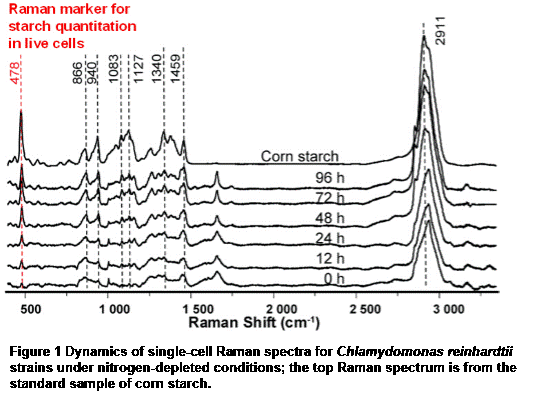Microalgae are able to convert solar energy and carbon dioxide to energy storage compounds such as starch and lipids to produce food and biofuels. Therefore screening and engineering strains for higher starch productivity have been of great interest. Multiple methods have been developed to measure the starch content in tissues and cellular biomass, however they usually require multiple steps that include extraction of starch from cells, hydrolyzation with either acids or enzymes to glucose, which is subsequently quantified colorimetrically via enzymatic reactions. These methods are invasive, labor intensive, limited in throughput and demanding in terms of reagents and consumables. On the other hand, as these methods require the cumulative biomass from a large number of cells and thus are culture-dependent, wild-type or mutant cells that are not yet cultured or difficult to cultivate have been beyond the reach of these approaches.
A research team from Single-Cell Center, Qingdao Institute of BioEnergy and Bioprocess Technology, Chinese Academy of Sciences (QIBEBT, CAS) has now established a novel approach for quantitation of starch in live, unicellular microalgae at single-cell resolution. The work is published in Biotechnology Journal.

A nearly linear correlation (R2=0.99) between the Raman signal intensity at 478 cm−1and the starch content of algal biomass was validated in both Chlamydomonas reinhardtii andChlorella pyrenoidosa (Figure 1). Compared to existing methods that measure the starch content in tissues and bulk cellular biomass, this SCRS-based approach is rapid, label-free, noninvasive, culture-independent, low-cost and potentially able to simultaneously track multiple metabolites in individual live cells. As throughput, ease of deployment, cost and multiplexing are all important considerations in design of starch assays, such advantages can be exploited for development of many novel applications such as screening of microbial cell factories and optimization of bioprocesses.
This research was supported by the National Basic Research Program, the High-Tech Development Program, as well as the International Innovation Partnership Program from the Chinese Academy of Sciences. Prof. XU Jian of Single-Cell Center, QIBEBT, CAS led the study.